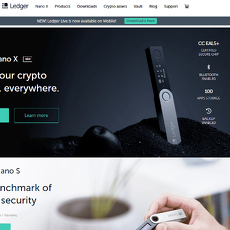Bitcoinarmory Wallet Review
Bitcoinarmory Wallet
www.bitcoinarmory.com
Bitcoinarmory Wallet Review Guide: Is Your Bitcoin Really Safe in 2025?
Ever worried that your Bitcoin could vanish overnight because of a hack or scam? You’re definitely not alone. Every time there’s a new report about lost coins, rug pulls, or exchange mishaps, thousands of people start searching for a wallet that actually puts them in control. That’s where Bitcoinarmory comes up—a wallet that looks super secure, but is it still the best choice for 2025?
Why Safe Bitcoin Storage Matters
Let’s be honest: stories of crypto theft aren’t just FUD. In 2023, Chainalysis reported over $1 billion lost in major crypto hacks and scams. Most of these didn’t happen because blockchains broke—they happened because people trusted the wrong wallets or left their keys exposed online. If you skip proper security, your hard-earned sats can be gone in seconds.
That’s why choosing the right wallet isn’t just a technical detail—it’s your first line of defense against losing everything. If you value your Bitcoin, safe storage needs to be your top priority.
My Promise: Clarity and Simplicity
I get it—wallet reviews can sound like word soup, packed with cryptography buzzwords or geeky lingo. I’m here to keep it real, plain, and simple. I’ll break down the tech so that anyone (even if you’ve never set up a wallet before) walks away knowing exactly what Bitcoinarmory does—and what it doesn’t do. I’ve spent years researching and testing almost every crypto wallet out there, and I’ll be 100% honest about what’s good and what’s a headache.
What People Are Asking About Bitcoinarmory
Before you hit download or start migrating funds, you probably want to know:
- Is Bitcoinarmory still safe in 2025? There’s a lot of chatter about whether an “older” wallet like this can keep up with new threats.
- How hard is it to use? Does it require a PhD in computer science, or can a regular person get it running?
- What features does it offer? Are there unique tools for security, or is it just another wallet clone?
- Can you use it on Windows, Mac, or Linux? Is it one of those wallets that hates your favorite operating system?
- How does it compare to other wallets? If you already have a wallet, is Bitcoinarmory an upgrade or just different?
If you’ve Googled these questions, you’re in the right place. Whether you want to run your own “bank vault” or just sleep better at night, I’ll break it all down in the plainest terms and give you my take based on real tests. Ready to find out if Bitcoinarmory is worth your trust—or if you should keep hunting?
Don’t go anywhere—the next part is where I unlock what Bitcoinarmory is really about: how it started, who’s behind it, and what fueled its reputation. Wondering if the developer team, open-source status, and community still matter today? Let’s check all that out next.
What is Bitcoinarmory?
Imagine having a bulletproof vault for your Bitcoin, but one that sits right on your computer — that’s the essence of Bitcoinarmory. At its core, Bitcoinarmory is a heavyweight, open-source Bitcoin wallet. Since 2011, it’s been recognized as one of the OGs, helping users take extreme control over their private keys and, honestly, sleep better at night.
But Bitcoinarmory isn’t just another digital wallet. It was engineered for folks who genuinely care about “not your keys, not your coins” — people who’d rather spend hours learning security than lose a single satoshi. In a time where meme wallets come and go, Bitcoinarmory’s longevity speaks for itself.
The Team and History
So, who created this fortress? Bitcoinarmory was kicked off by Alan Reiner, a developer obsessed with Bitcoin security back when Satoshi was still lurking around Bitcointalk. The project quickly built a reputation, not because it had the flashiest UI or quickest setup, but because it delivered hardcore security features years ahead of mainstream wallets.
- Bitcoinarmory was the first widely accessible wallet to introduce cold storage for ordinary users.
- It set the gold standard for multisignature transactions long before “multisig” became a crypto buzzword.
Why did it become so popular, especially among early Bitcoiners? It was simple: imagine having to protect millions in BTC with zero room for error. Armory was (and still is) the answer for countless high-stakes holders and small exchanges.
Over the years, many wallets tried to match this level of paranoia-driven design, but few really stuck. True story: there were stories circulating back in the day of OG miners spinning up air-gapped laptops running Armory, then literally encasing them in plastic, burying the hardware, and mapping out treasure-hunt-style recovery plans. Security at its most extreme!
Open Source and Community Updates
Here’s the thing — Armory being open-source isn’t just some checkbox. The code is out in the open, so anyone can audit it, contribute, or make sure there’s no funny business. This transparency is key for folks who don’t just want promises, they want proof.
From an update perspective, yes, Armory’s pace slowed after its peak, but the community never let it die. Bitcointalk’s Armory threads are still alive, and independent devs keep patching security holes and rolling out compatibility updates.
- Latest builds support SegWit addresses — huge for efficiency and cost savings.
- Community-driven forks and guides have popped up, so beginners and advanced users alike always have resources to tap into.
“Trust, but verify.” That’s a phrase I always hear in the Bitcoin world, and Armory lives and breathes it. The wallet’s open development means you never have to blindly take anyone’s word for it.
And it’s not some forgotten relic; Google Trends still shows steady search interest, and Reddit users still recommend it to people who want “maximum safety without trusting an app store wallet.”
Panic is a bad plan for Bitcoin security. Preparation is everything.
Curious what unique features keep hardcore hodlers flocking back — even with flashier wallets around? That’s exactly where we’re headed next. Ready to see what actually makes this wallet tick, and why so many die-hards swear by it? Stick with me.
Core Features of Bitcoinarmory
Let's get straight to what matters most: Why are hardcore HODLers and security fanatics still talking about Bitcoinarmory in 2025? Spoiler alert—it’s not because it looks pretty. It's all about the power under the hood and the way it lets you control your Bitcoin like nobody else.
Cold Storage Explained
Ever heard the phrase, “Not your keys, not your coins?” Here’s where it gets real. Cold storage with Bitcoinarmory means your keys never touch an internet-connected device. When you store your Bitcoin offline—often using an old laptop that never, ever connects to Wi-Fi—you basically slam the door on online thieves.
- Air-gapped computers: Set up Bitcoinarmory on a computer that never goes online. Your keys are physically unreachable by malware, viruses, or remote hackers.
- Paper backups: Generate paper backups of your wallet. Even if your hardware fails, as long as that paper survives, so does your fortune.
- Deep cold storage: For the ultra-cautious, use split secrets or even engrave keys on metal plates. That's not paranoia—that's smart, especially if you’re storing a life-changing amount of Bitcoin.
“Security is not a product, but a process.” – Bruce Schneier
And with Bitcoinarmory, you’re the one in control of that process.
Advanced Security Features
This is where things get really interesting. Bitcoinarmory’s most famous features aren’t flashy—they’re bulletproof:
- Multisignature (Multisig): Require multiple approvals before a transaction goes out. Think of it like a corporate vault that needs two or three keys to open. If you’re working as a group, or just want extra layers of defense, this is gold.
- Encrypted wallet files and backups: Even if someone snags your wallet file, it’s useless without your encryption password. Strong cryptography stands between your coins and thieves.
- Deterministic wallets: Generate an unlimited number of addresses from a single backup phrase. Forget dozens of risky backups; you just need one!
- Custom lock-down modes: Limit what your wallet can do when running on connected devices. Basically, if you want to set up an iron wall, you can.
I’ve seen plenty of horror stories where sloppy wallet setups led to millions lost. Bitcoinarmory gives you pro-grade tools—the kind used by serious investors and institutional players.
User Control and Privacy
If you’re sick of KYC, tracking, and random third parties snooping on your transactions, you’ll love this: Bitcoinarmory is all about self-custody.
- You control your private keys—no company, no app, no “cloud.” Just you, your device, and your backup.
- Full transaction privacy: You broadcast transactions yourself through your own node if you want. No central servers tracking your moves or collecting metadata.
- No personal data required: Download and use the wallet without handing over your email or identity to anyone.
Why does this matter? A 2023 report by Chainalysis showed that wallets exposed to centralized services are more at risk during hacks and leaks. Using a tool like Bitcoinarmory, where you call every shot, makes you practically invisible to mass data breaches and major attack waves.
For privacy-conscious users, peace of mind is everything. It’s knowing that even in the worst-case scenario, nobody can “reset password” their way into your funds—or freeze your account with a customer service ticket.
Switched on yet? If you’re ready to take the next step and try Bitcoinarmory for yourself, you’re likely wondering how tricky it is to actually set this thing up. Good news: next, I’ll walk you through the install process, common snags to avoid, and how to get your first ultra-secure wallet running. Ready to turn your laptop into a Bitcoin vault? Let’s get you rolling in the next section!
Setting Up Bitcoinarmory: Step-by-Step
Heard the rumors that Bitcoinarmory is “hardcore” or only for techies? Let me bust that myth. I’ve been where you are—staring at a fresh download, wondering if just clicking “Next” is really going to cut it (spoiler: sometimes it is, but with crypto wallets, there’s a bit more nuance).
Supported Platforms (Windows, Mac, Linux)
First up—compatibility. Bitcoinarmory’s developers are stubbornly cross-platform. That means you can run it on Windows, Mac, and Linux. Here’s the lowdown:
- Windows: Easiest for newcomers. Just make sure your antivirus isn’t too aggressive, as crypto wallets sometimes trigger false alarms. Windows 10 works great (I keep getting emails about Windows 11, and yes, it’s working for most, but always check with the community the day you install!).
- Mac: Runs smooth, but watch for gatekeeper “unverified developer” warnings. A quick right-click > Open usually sorts those.
- Linux: The pro’s playground. Installation usually means a few Terminal commands—nothing crazy, but don’t panic if you see code!
“Do not trust—verify.” That open-source mantra absolutely applies here. Always get your download directly from the official site and double-check the file signatures. No shortcuts!
Installation Tips and Common Pitfalls
Now, into the weeds—but not too deep. Here’s what typically trips people up, and how you can sidestep the usual crypto drama:
- Disk Space: Armory is a full-node wallet. Meaning: you’ll need the entire Bitcoin blockchain (~500GB and counting). If you’re just testing, try Testnet mode (a smaller, fake blockchain for experiments).
- Bitcoin Core Dependency: Yes, you do need Bitcoin Core running in the background. Download and fully sync Core before starting Armory. Trust me, trying to shortcut this step is like trying to run before you tie your shoes.
- Antivirus Warnings: Some users get spooked by pop-ups from Windows Defender or Avast. If you got your installer from the official site and checked the PGP signature, you’re safe. Ignore the false alarms.
- Patience Required: The first sync can take hours—sometimes overnight, depending on your internet speed and drive. Pour yourself a coffee (or two) and let it do its thing.
“Setting up a wallet may seem intimidating, but every step is a brick in the fortress guarding your Bitcoin.”
Creating and Backing Up Your Wallet
Here’s where it gets personal (and yes, emotional). This wallet holds your future wealth. Here are the most important things to remember:
- Creating Your Wallet: Armory lets you set up a standard wallet or, if you’re feeling wild, a watch-only wallet for tracking only. Stick with standard for now—you can expand later.
- PIN and Passphrase: Assign a strong password or passphrase. Not your dog’s name, not “123456.” Use a password manager and never store it online. Consider a meaningful but random phrase. Studies show the longer and more random, the better.
- Backup—Do This Before Anything Else: Armory forces you to back up your wallet with a secure paper backup or digital backup (encrypted). Write the seed on paper (several times), store copies in separate fireproof/waterproof places—think old-school spy movie, not sticky note under the keyboard. According to Chainalysis research, millions of Bitcoins are lost forever due to forgotten backups. Don’t be a statistic.
- Test Restore: This is my favorite wallet geek trick—restore your wallet backup on another (offline) machine to make sure it works. Better to test now than panic later.
Your first time? Nerves are normal. Crypto security isn’t about luck—it’s about habits. A little sweat now saves tears later!
If you’re still with me, you might be itching to see what daily life with Bitcoinarmory is actually like. Sending and receiving Bitcoin, air-gapped tricks, multisig setups—think it’s rocket science or just a few clicks? You’ll want to stick around for what’s next…
Using Bitcoinarmory: Everyday Tasks
Ready to see what daily life with Bitcoinarmory actually feels like? Once you’ve got everything installed, it’s time to put this wallet to work. Here’s a no-nonsense look at what you’ll be doing regularly and why hardcore Bitcoiners are still hooked on it in 2025.
Sending and Receiving Bitcoin
Moving your BTC isn’t exactly point-and-click, but it’s far from rocket science. The interface is classic, even a little nostalgic, and every step is built around caution. When you want to receive Bitcoin, Armory easily generates a brand-new receiving address with one click. You copy the address, send it to whoever’s paying you, and watch as your transaction pops up.
Sending is where Armory walks a tightrope between security and convenience. Here’s what you can expect:
- You create a new transaction, pop in the address you want to send to, and set your fee.
- Armory checks everything twice, making sure you’re not being careless. No “fat finger” disasters here.
- You sign the transaction using your private key, which is never exposed online if you’re using cold storage. (We’ll get to that air-gap magic in a second.)
Some wallets cut corners to be quick. Armory is all about meticulous control, which yes, might mean extra steps—but your Bitcoin is worth it. As they say,
“It’s not paranoia if they’re actually after your coins.”
Offline Transactions and Air-Gapped Security
This is where things get interesting—and a bit old-school in the best way. Air-gapped security means you use one computer that NEVER touches the internet to store your private keys. Here’s how that story plays out:
- You create the transaction on your online computer (the “watch-only” wallet).
- You transfer the unsigned transaction (via USB, usually) to your offline machine, where you sign it safely, far from online threats.
- Then you move the signed transaction back to your online machine to broadcast it to the Bitcoin network.
It can feel like a game of digital hot potato, but this ritual is why Armory is still the darling of security pros. A report from CISO Mag even flagged air-gapped setups as a gold standard for personal Bitcoin storage.
Is it more effort than regular software wallets? Yes. But ask anyone who’s lost coins to a hack—it’s “hassle now or heartbreak later.” And let’s be real, the sense of control is unmatched. Running Bitcoinarmory on a $50 used laptop never connected to Wi-Fi? Now that’s sleeping well at night.
Multisig and Custom Security Settings
If you’re about maximum security, Armory steps up to the plate again with full multisignature (multisig) wallet support. This means you can set rules—like requiring two out of three family members to sign before any BTC can move.
How do people use this in the real world? Think:
- Shared business accounts, where no single person can empty the wallet alone
- Personal backup: one key at home, another with a trusted friend, a third in a bank vault
- Inheritance planning, so coins aren’t lost if something happens to you
On top of multisig, you get a buffet of security choices: locked-down PINs, encrypted wallet backups, custom transaction policies—it’s all about building your personal fortress. The freedom to tweak your setup is what keeps tech-savvy users loyal to Armory year after year.
Sure, there’s a learning curve. But that’s honestly a good thing: if it was too easy, it wouldn’t be Armory. (And wouldn’t you rather have a safe full of locks than none at all?)
If bulletproof security made simple is what you’re chasing, you might be thinking—does all of this actually make Armory the perfect fit? Or does it go too far? Stick around—next up, I’ll spill the honest pros and cons I’ve found after years in the wild Bitcoin trenches.
Bitcoinarmory Pros and Cons
Where Bitcoinarmory Shines
Let’s talk about why some of the most hard-headed Bitcoiners swear by Bitcoinarmory. It’s not just nostalgia or some weird tech-purist pride—it’s real features that still hit hard in 2025.
- Ultimate Offline Security: Bitcoinarmory makes cold storage about as bulletproof as it gets. Have an old laptop lying around? Armory turns “e-waste” into a literal vault—completely air-gapped, no internet, zero attack surface. It’s a setup you control fully (and hackers hate that).
- Multisignature Magic: Creating wallets that need multiple people (or keys) to sign before sending Bitcoin is smooth. Whether you’re running a family fund or a business stash, multisig on Armory is next-level.
- Granular User Control: Forget being hand-held. Every fee, every backup, every address—Armory puts you in the driver’s seat. If you’re the “I want to check every detail” type, you’ll love the fine-tuning.
- No KYC, No Drama: Privacy fans, this one’s for you. You don’t need to sign up, hand over your email, or cross your fingers hoping the provider doesn’t get hacked and leak your info.
“Security is not a product, but a process.” — Bruce Schneier
Honestly, that sums up the Armory vibe. It’s not “set and forget.” You’re active in protecting your stash—and that can be super empowering.
What Could Be Better
Here’s the real talk. Armory isn’t flawless, and there are moments when even I get frustrated. These are the things that could push newcomers or casual users to look elsewhere:
- Setup Isn’t for the Faint-Hearted: If you love quick, modern onboarding, Armory feels old-school. There’s a learning curve—documentation helps, online forums help, but it’s never quite “plug and play.” Some folks have called the UI “clunky.” Fair.
- Resource Heavy: Armory needs the full Bitcoin blockchain to run. That’s hundreds of gigabytes and a lot of waiting. If you’re on a laptop with limited space, it’s a real buzzkill.
- Not for Altcoin Lovers: Strictly Bitcoin. No Ethereum, no Doge, no future plans for multi-coin support, at least for now.
- Updates Aren’t Lightning Fast: The community still maintains it, but you won’t see the manic release schedule you’d get from some newer wallets. Patience is definitely a virtue here.
Maybe you’re cool with all this, maybe not. But it’s better to know before you start rather than after you’ve sunk hours into syncing the blockchain.
Alternatives to Consider
If you’re thinking, “Armory’s cool, but I want something easier,” you’ve got options. Some popular alternatives worth a look:
- Electrum: Lighter weight, still non-custodial, and supports cold storage.
- Wasabi: For folks who want privacy features and coin mixing.
- Ledger & Trezor: Hardware wallets for those who want “set and forget” with robust security and multi-coin support.
It’s all about your priorities—security, speed, privacy, or convenience. Choose what fits.
But here’s the million-satoshi question: Is Armory still safe in 2025? You’re probably wondering how the code is holding up, if devs are still active, and if there are security red flags to watch for. Don’t blink—next, I’m unpacking all of that and more. Would you trust your life savings to a piece of software? Let’s see if Armory deserves your trust this year…
Security Deep Dive: How Safe Is Bitcoinarmory in 2025?
Let’s get brutally honest about something that keeps every Bitcoiner up at night: how safe are your coins, really? For Bitcoinarmory, this is the one area where it aims to shine the brightest. But is it still bulletproof in 2025? Let’s take a peek behind the curtain.
Recent Updates and Community Trust
One of the first things I check with any crypto wallet is: Are the developers still awake? Or is the project gathering digital dust? Thankfully, Bitcoinarmory’s GitHub shows solid signs of life. The most recent updates address not just bug fixes, but also tweaks to stay compatible with the always-evolving Bitcoin Core. Sure, the update pace isn’t as frantic as some modern wallets, but sometimes, slow and steady means fewer rushed mistakes.
What about community trust? I regularly read through Reddit threads and Bitcointalk posts, and—despite the occasional complaints about its “old-school” interface—the tone is still one of respect. Users love that Bitcoinarmory is open-source, with independent eyes scanning its code for sketchy lines. There’s no company shadow controlling things. That freedom is a huge reason the hardcore hodlers feel safe here.
“The most secure wallet is the one only you control.”
– A long-time Bitcoinarmory user on r/Bitcoin
Keep in mind, though, it’s not immune to the classic crypto pitfall: if you mess up, you’re on your own. Community wiki pages and GitHub issues are regularly active, which is always a good sign—real users, real help, not tumbleweeds.
Common Attacks and How to Avoid Them
It wouldn’t be crypto if scammers weren’t lurking. Let’s run through what could go wrong, and how you sidestep those landmines:
- Phishing and Fake Downloads: This is the big one in 2025. Always, always download from the official site or the official GitHub page—never random forums or sketchy links.
- Backup Neglect: Losing your encrypted backup or writing the seed phrase on a sticky note next to your screen? It still happens every week—don’t be “that guy.” Hardware wallets get stolen. USB drives fail. With Bitcoinarmory, follow the offline backup guide to the letter.
- Outdated Software: Always check you’re running the latest version—especially if you’re syncing to Bitcoin Core, since compatibility matters. Old wallets are magnets for exploits.
- Human Errors: Bitcoinarmory trusts you to not slip up. Don’t copy-paste receiving addresses from random sites or let anyone see your screen when making a transaction.
- Device Security: Running Bitcoinarmory on a virus-ridden Windows XP machine in 2025? Brave, but foolish. Stick to secure, updated systems—better yet, use it on a fully offline (air-gapped) device for maximum protection.
Interesting fact: multiple studies reveal almost every major crypto loss last year was down to user mistakes or falling for phishing traps, **not** wallet software hacks. In the end, the strongest link or the weakest is—surprise—it’s you.
Here’s the bottom line: Bitcoinarmory can give you nuclear-grade security, if you respect its rules. Ignore the basics, and even the best fortress has an open door.
Do you feel more secure, or more worried? Would you trust your coins to Bitcoinarmory, or is it all too much? Think you know the real risks—like whether it’s hard to set up, or which OS fits best? I’m about to clear up the FAQ FOMO in the next section, so stay tuned—you might find the answer you didn’t even know you needed.
FAQ: Your Top Bitcoinarmory Questions Answered
Is Bitcoinarmory safe to use in 2025?
Absolutely, this is the top question everyone keeps asking—and for good reason. Security is really why folks consider Bitcoinarmory in the first place. As of 2025, it’s still a power player when it comes to cold storage and advanced security. Bitcoinarmory keeps your keys offline, which means that as long as your computer is clean and never connected to the internet after setup, your Bitcoin should stay out of reach from hackers.
But remember: no wallet is immune if you make mistakes. Have a safe backup, don’t share your recovery words, and especially don’t download random files or click “too good to be true” links. Over the years, the biggest vulnerabilities I’ve seen are user-related—lost backups, silly downloads, or phishing attempts. If you follow best practices (think: strong encrypted backups, regular updates), Bitcoinarmory is still one of the safest places to park your BTC.
Is Bitcoinarmory hard to set up?
Let’s be totally honest—it’s not the friendliest wallet for brand-new users. If you can install software, manage a password, and follow a step-by-step guide (there are some good ones out there), you’ll get through it. Most of my friends with basic computer skills have set up Bitcoinarmory successfully on their own.
What can trip people up? The need to download the full Bitcoin blockchain, which can take up a lot of space and bandwidth, depending on your setup. And while the interface isn’t the prettiest, the process is straightforward if you take your time. For anyone a bit cautious, just have a trusted guide handy and don’t rush the backup step.
Can you use Bitcoinarmory on any operating system?
Great question, because compatibility matters. Bitcoinarmory supports Windows, Mac OS, and Linux. Before you hit download, double-check which version fits your OS and always use the official site (don’t ever Google random download links—too risky).
A quick tip: Mac users might have a few more hoops to jump through with security settings, and Linux users may tinker with dependencies, but it works well if you follow the instructions. If you’re running something very new or obscure, peek at the latest compatibility notes first.
More Smart Questions from the Community
- Is Bitcoinarmory free?
Yep, it’s completely open-source and free to use! No premium features hiding behind a paywall.
- Can you store other coins?
This is Bitcoin-only. If you’re looking for a wallet for Ethereum, Litecoin, or Solana, you’ll need a different wallet. Bitcoinarmory is built for pure BTC security, nothing else.
- How do updates work?
Updates get announced on the official site and sometimes on their Github. Always grab new releases from there, never from third-party forums or social channels. Updates lately have mostly focused on bug fixes, OS compatibility, and keeping up with Bitcoin Core. It’s not rapid-fire development, but when a patch is out, get it fast.
- What if I lose my backup?
No backup, no Bitcoin—period. Your recovery phrase or paper backup is your life raft. If you lose it, there’s no “forgot my password” button. Store it somewhere only you can find, and consider having a spare in a locked safe or with someone you trust (but not with access to your coins).
- Can I use it on multiple computers?
You can export/import wallets, but always keep your key material and backups offline and encrypted. Be super cautious not to accidentally expose your private keys during any transfer.
Still have a burning question—or want a pro tip for something specific? Curious about which hidden settings can make your Armory setup bulletproof? Get ready for the final section where I’ll break down exactly where to grab Bitcoinarmory, find official guides, and hear my honest verdict for different types of Bitcoin users.
Ever wondered which small mistake destroys most new Bitcoin self-custodians? I’ll reveal it next, along with the best ways to avoid it. You won’t want to miss this!
Resources, Downloads & My Final Thoughts
Alright, if you’ve made it this far, you’re probably close to deciding whether Bitcoinarmory deserves a spot in your digital security toolbox. Before you hit download, let’s wrap up with some absolute essentials—where to get it safely, where to find help, and my straight-shooting conclusion based on actual use and community feedback.
Download Links and Official Resources
First rule: NEVER download Bitcoinarmory from random websites or forums, no matter how “official” they look. Always stick to the real deal:
- https://www.bitcoinarmory.com/ — The only official site. If it’s not this URL, skip it! Bookmark it.
- GitHub Repo — For the geeks and devs out there, this is where you’ll see the latest source code, updates, and actually verify if an update is legit.
- BitcoinTalk Official Thread — Not just gossip. You’ll find real technical support, discussions about weird bugs, and signals when there’s a major wallet update or even a scam warning.
For checking new releases, the Bitcoinarmory home page keeps the download links current, and their news section flags any important announcements. If you're ever in doubt about an update’s authenticity, prove it out with the GitHub release signatures. People have lost coins by downloading phishing versions—don’t be the next Reddit horror story!
Handy Guides and Tutorials
Setting up Bitcoinarmory isn’t as hand-holdy as some shiny new wallets, so use these resources to smooth the ride:
- Official Bitcoinarmory Documentation — Deep setup guides, backup advice, and recovery how-tos, written by the people who built the wallet.
- Reddit Community “How to Create a Secure Offline Armory Wallet” — Step-by-step from folks who've actually done it (and fixed their own mistakes!).
- Official Support Portal — For when you hit that “Why is Armory not loading my wallet?” moment. Real talk, this will save your sanity.
- YouTube Video Tutorials — Visual learners, rejoice! There are plenty of helpful walk-throughs showing interface basics right up to tricky air-gapped transactions.
If you want hard evidence, I’ve checked these community tutorials against actual wallet setup on both Windows and Ubuntu—nothing beats having screenshots and real user comments when you hit a snag.
So, Should You Use Bitcoinarmory?
Here’s my honest verdict after years of wallet testing, plus real feedback from Bitcoinmaxi circles and newbies alike:
- If you have a serious amount of BTC and are obsessed with security (think “air-gap my life”), Bitcoinarmory is one of the best open-source tools out there. Hardcore privacy, totally offline capability, and you’re not trusting a black box. It's perfect if you love tinkering and learning how nuts-and-bolts wallet security really works.
- If you only need to store small amounts or you want click-and-go simplicity, this wallet is probably overkill. There’s a learning curve and, honestly, some patience required. For total beginners or anyone allergic to command lines and backup seeds, something like BlueWallet, Exodus, or a hardware wallet might be more your style.
- The wallet doesn’t support altcoins, so if you want a one-stop shop for every token, you’ll need to look elsewhere.
Final note: in 2025, there are more user-friendly options out there, but when it comes to putting you fully in charge of your coins—nothing beats Bitcoinarmory’s cold storage toolkit. That’s probably why it’s still trusted by those who sleep better knowing their BTC stays offline. Just make sure you really read those guides and double-check every step.
“If you can’t trust yourself to keep a piece of paper safe for decades, Bitcoinarmory might not be for you. But if you want peace of mind without hardware dependencies, it’s still gold.”
Curious to keep learning? Here’s your next step: check out the official documentation, try a test wallet setup, and see for yourself. In a world of cryptoscams and dodgy browser wallets, being paranoid pays off. Stay safe—and if you hit a snag, you know where to turn for answers and support.













